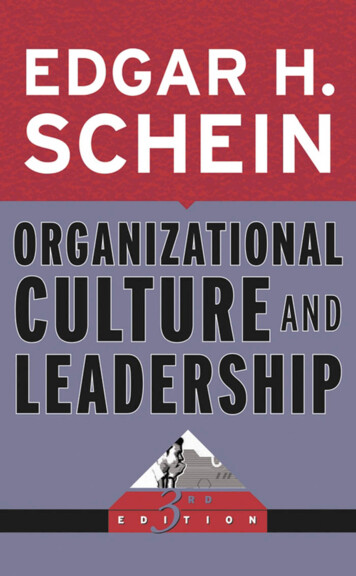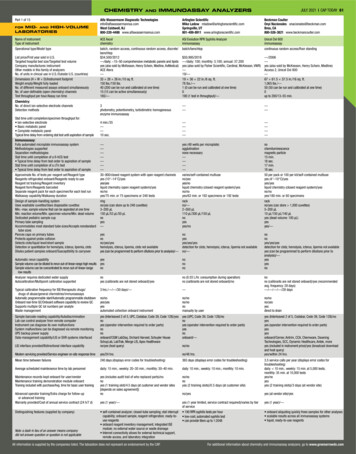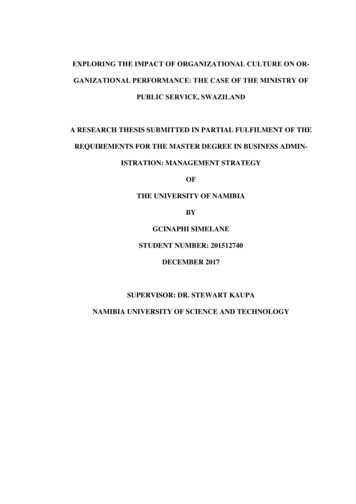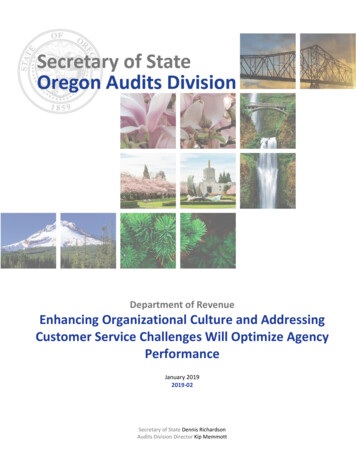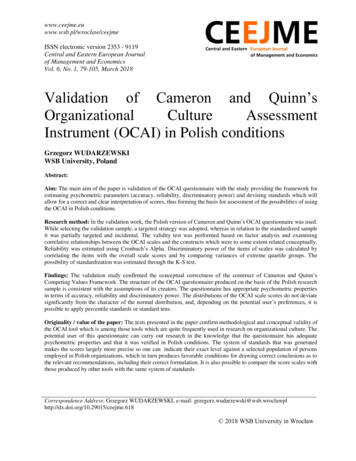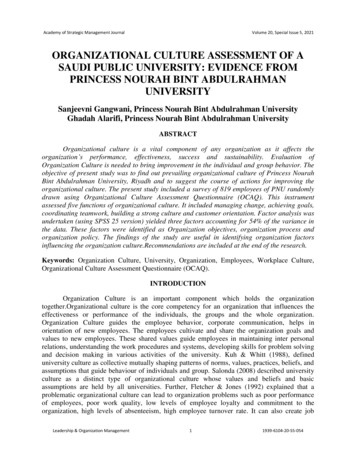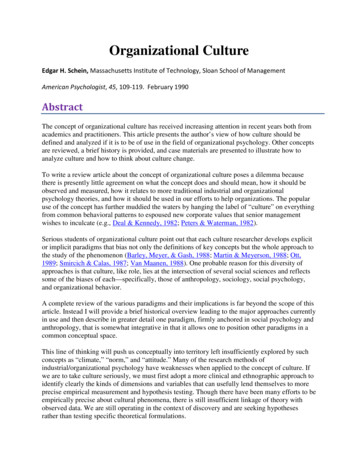
Transcription
Organizational CultureEdgar H. Schein, Massachusetts Institute of Technology, Sloan School of ManagementAmerican Psychologist, 45, 109-119. February 1990AbstractThe concept of organizational culture has received increasing attention in recent years both fromacademics and practitioners. This article presents the author’s view of how culture should bedefined and analyzed if it is to be of use in the field of organizational psychology. Other conceptsare reviewed, a brief history is provided, and case materials are presented to illustrate how toanalyze culture and how to think about culture change.To write a review article about the concept of organizational culture poses a dilemma becausethere is presently little agreement on what the concept does and should mean, how it should beobserved and measured, how it relates to more traditional industrial and organizationalpsychology theories, and how it should be used in our efforts to help organizations. The popularuse of the concept has further muddied the waters by hanging the label of “culture” on everythingfrom common behavioral patterns to espoused new corporate values that senior managementwishes to inculcate (e.g., Deal & Kennedy, 1982; Peters & Waterman, 1982).Serious students of organizational culture point out that each culture researcher develops explicitor implicit paradigms that bias not only the definitions of key concepts but the whole approach tothe study of the phenomenon (Barley, Meyer, & Gash, 1988; Martin & Meyerson, 1988; Ott,1989; Smircich & Calas, 1987; Van Maanen, 1988). One probable reason for this diversity ofapproaches is that culture, like role, lies at the intersection of several social sciences and reflectssome of the biases of each—specifically, those of anthropology, sociology, social psychology,and organizational behavior.A complete review of the various paradigms and their implications is far beyond the scope of thisarticle. Instead I will provide a brief historical overview leading to the major approaches currentlyin use and then describe in greater detail one paradigm, firmly anchored in social psychology andanthropology, that is somewhat integrative in that it allows one to position other paradigms in acommon conceptual space.This line of thinking will push us conceptually into territory left insufficiently explored by suchconcepts as “climate,” “norm,” and “attitude.” Many of the research methods ofindustrial/organizational psychology have weaknesses when applied to the concept of culture. Ifwe are to take culture seriously, we must first adopt a more clinical and ethnographic approach toidentify clearly the kinds of dimensions and variables that can usefully lend themselves to moreprecise empirical measurement and hypothesis testing. Though there have been many efforts to beempirically precise about cultural phenomena, there is still insufficient linkage of theory withobserved data. We are still operating in the context of discovery and are seeking hypothesesrather than testing specific theoretical formulations.
A Historical NoteOrganizational culture as a concept has a fairly recent origin. Although the concepts of “groupnorms” and “climate” have been used by psychologists for a long time (e.g., Lewin, Lippitt, &White, 1939), the concept of “culture” has been explicitly used only in the last few decades. Katzand Kahn (1978), in their second edition of The Social Psychology of Organizations, referred toroles, norms, and values but presented neither climate nor culture as explicit concepts.Organizational “climate,” by virtue of being a more salient cultural phenomenon, lent itself todirect observation and measurement and thus has had a longer research tradition (Hellriegel &Slocum, 1974; A. P. Jones & James, 1979; Litwin & Stringer, 1968; Schneider, 1975; Schneider& Reichers, 1983; Tagiuri & Litwin, 1968). But climate is only a surface manifestation of culture,and thus research on climate has not enabled us to delve into the deeper causal aspects of howorganizations function. We need expalanations for variations in climate and norms, and it is thisneed that ultimately drives us to “deeper” concepts such as culture.In the late 1940s social psychologists interested in Lewinian “action research” and leadershiptraining freely used the concept of “cultural island” to indicate that the training setting was insome fundamental way different from the trainees’ “back home” setting. We knew from theleadership training studies of the 1940s and 1950s that foremen who changed significantly duringtraining would revert to their former attitudes once they were back at work in a different setting(Bradford, Gibb, & Benne, 1964; Fleishman, 1953, 1973; Lewin, 1952; Schein & Bennis, 1965).But the concept of “group norms,” heavily documented in the Hawthorne studies of the 1920s,seemed sufficient to explain this phenomenon (Homans, 1950; Roethlisberger & Dickson, 1939).In the 1950s and 1960s, the field of organizational psychology began to differentiate itself fromindustrial psychology by focusing on units larger than individuals (Bass, 1965; Schein, 1965).With a growing emphasis on work groups and whole organizations came a greater need forconcepts such as “system” that could describe what could be thought of as a pattern of norms andattitudes that cut across a whole social unit. The researchers and clinicians at the TavistockInstitute developed the concept of “socio-technical systems” (Jaques, 1951; Rice, 1963; Trist,Higgin, Murray, & Pollock, 1963), and Likert (1961, 1967) developed his “Systems 1 through 4”to describe integrated sets of organizational norms and attitudes. Katz and Kahn (1966) built theirentire analysis of organizations around systems theory and systems dynamics, thus laying themost important theoretical foundation for later culture studies.The field of organizational psychology grew with the growth of business and managementschools. As concerns with understanding organizations and interorganizational relationshipsgrew, concepts from sociology and anthropology began to influence the field. Cross-culturalpsychology had, of course, existed for a long time (Werner, 1940), but the application of theconcept of culture to organizations within a given society came only recently as moreinvestigators interested in organizational phenomena found themselves needing the concept toexplain (a) variations in patterns of organizational behavior, and (b) levels of stability in groupand organizational behavior that had not previously been highlighted (e.g., Ouchi, 1981).
What has really thrust the concept into the forefront is the recent emphasis on trying to explainwhy U.S. companies do not perform as well as some of their counterpart companies in othersocieties, notably Japan. In observing the differences, it has been noted that national culture is nota sufficient explanation (Ouchi, 1981; Pascale & Athos, 1981). One needs concepts that permitone to differentiate between organizations within a society, especially in relation to differentlevels of effectiveness, and the concept of organizational culture has served this purpose well(e.g., O’Toole, 1979; Pettigrew, 1979; Wilkins & Ouchi, 1983).As more investigators and theoreticians have begun to examine organizational culture, thenormative thrust has been balanced by more descriptive and clinical research (Barley, 1983;Frost, Moore, Louis, Lundberg, & Martin, 1985; Louis, 1981, 1983; Martin, 1982; Martin,Feldman, Hatch, & Sitkin, 1983; Martin & Powers, 1983; Martin & Siehl, 1983; Schein, 1985a;Van Maanen & Barley, 1984). We need to find out what is actually going on in organizationsbefore we rush in to tell managers what to do about their culture.I will summarize this quick historical overview by identifying several different research streamsthat today influence how we perceive the concept of organizational culture.Survey ResearchFrom this perspective, culture has been viewed as a property of groups that can be measured byquestionnaires leading to Likert-type profiles (Hofstede, 1980; Hofstede & Bond, 1988; Kilmann,1984; Likert, 1967). The problem with this approach is that it assumes knowledge of the relevantdimensions to be studied. Even if these are statistically derived from large samples of items, it isnot clear whether the initial item set is broad enough or relevant enough to capture what may forany given organization be its critical cultural themes. Furthermore, it is not clear whethersomething as abstract as culture can be measured with survey instruments at all.Analytical DescriptiveIn this type of research, culture is viewed as a concept for which empirical measures must bedeveloped, even if that means breaking down the concept into smaller units so that it can beanalyzed and measured (e.g., Harris & Sutton, 1986; Martin & Siehl, 1983; Schall, 1983; Trice &Beyer, 1984; Wilkins, 1983). Thus organizational stories, rituals and rites, symbolicmanifestations, and other cultural elements come to be taken as valid surrogates for the culturalwhole. The problem with this approach is that it fractionates a concept whose primary theoreticalutility is in drawing attention to the holistic aspect of group and organizational phenomena.EthnographicIn this approach, concepts and methods developed in sociology and anthropology are applied tothe study of organizations in order to illuminate descriptively, and thus provide a richerunderstanding of, certain organizational phenomena that had previously not been documentedfully enough (Barley, 1983; Van Maanen, 1988; Van Maanen & Barley, 1984). This approachhelps to build better theory but is time consuming and expensive. A great many more cases areneeded before generalizations can be made across various types of organizations.
HistoricalThough historians have rarely applied the concept of culture in their work, it is clearly viewed asa legitimate aspect of an organization to be analyzed along with other factors (Chandler, 1977;Dyer, 1986; Pettigrew, 1979; Westney, 1987). The weaknesses of the historical method aresimilar to those pointed out for the ethnographic approach, but these are often offset by theinsights that historical and longitudinal analyses can provide.Clinical DescriptiveWith the growth of organizational consulting has come the opportunity to observe in areas fromwhich researchers have traditionally been barred, such as the higher levels of management wherepolicies originate and where reward and control systems are formulated. When consultantsobserve organizational phenomena as a byproduct of their services for clients, we can think ofthis as “clinical” research even though the client is defining the domain of observation (Schein,1987a). Such work is increasingly being done by consultants with groups and organizations, andit allows consultants to observe some of the systemic effects of interventions over time. Thisapproach has been labeled “organization development” (Beckhard, 1969; Beckhard & Harris,1977, 1987; Bennis, 1966, 1969; French & Bell, 1984; Schein, 1969) and has begun to be widelyutilized in many kinds of organizations.The essential characteristic of this method is that the data are gathered while the consultant isactively helping the client system work on problems defined by the client on the client’sinitiative. Whereas the researcher has to gain access, the consultant/clinician is provided accessbecause it is in the client’s best interest to open up categories of information that might ordinarilybe concealed from the researcher (Schein, 1985a, 1987a).The empirical knowledge gained from such observations provides a much needed balance to thedata obtained by other methods because cultural origins and dynamics can sometimes be observedonly in the power centers where elements of the culture are created and changed by founders,leaders, and powerful managers (Hirschhorn, 1987; Jaques, 1951; Kets de Vries & Miller, 1984,1986; Schein, 1983). The problem with this method is that it does not provide the descriptivebreadth of an ethnography nor the methodological rigor of quantitative hypothesis testing.However, at this stage of the evolution of the field, a combination of ethnographic and clinicalresearch seems to be the most appropriate basis for trying to understand the concept of culture.Definition of Organizational CultureThe problem of defining organizational culture derives from the fact that the concept oforganization is itself ambiguous. We cannot start with some “cultural phenomena” and then usetheir existence as evidence for the existence of a group. We must first specify that a given set ofpeople has had enough stability and common history to have allowed a culture to form. Thismeans that some organizations will have no overaching culture because they have no commonhistory or have frequent turnover of members. Other organizations can be presumed to have“strong” cultures because of a long shared history or because they have shared important intense
experiences (as in a combat unit). But the content and strength of a culture have to be empiricallydetermined. They cannot be presumed from observing surface cultural phenomena.Culture is what a group learns over a period of time as that group solves its problems of survivalin an external environment and its problems of internal integration. Such learning issimultaneously a behavioral, congnitive, and an emotional process. Extrapolating further from afunctionalist anthropological view, the deepest level of culture will be the cognitive in that theperceptions, language, and thought processes that a group comes to share will be the ultimatecausal determinant of feelings, attitudes, espoused values, and overt behavior.From systems theory, Lewinian field theory, and cognitive theory comes one other theoreticalpremise—namely, that systems tend toward some kind of equilibrium, attempt to reducedissonance, and thus bring basic categories or assumptions into alignment with each other(Durkin, 1981; Festinger, 1957; Hebb, 1954; Heider, 1958; Hirschhorn, 1987; Lewin, 1952).There is a conceptual problem, however, because systems contain subsystems, organizationscontain groups and units within them, and it is not clear over what range the tendency towardequilibrium will exist in any given complex total system.For our purposes it is enough to specify that any definable group with a shared history can have aculture and that within an organization there can therefore be many subcultures. If theorganization as a whole has had shared experiences, there will also be a total organizationalculture. Within any given unit, the tendency for integration and consistency will be assumed to bepresent, but it is perfectly possible for coexisting units of a larger system to have cultures that areindependent and even in conflict with each other.Culture can now be defined as (a) a pattern of basic assumptions, (b) invented, discovered, ordeveloped by a given group, (c) as it learns to cope with its problems of external adaptation andinternal integration, (d) that has worked well enough to be considered valid and, therefore (e) is tobe taught to new members as the (f) correct way to perceive, think, and feel in relation to thoseproblems.The strength and degree of internal consistency of a culture are, therefore, a function of thestability of the group, the length of time the group, the length of time the group has existed, theintensity of the group’s experiences of learning, the mechanisms by which the learning has takenplace (i.e., positive reinforcement or avoidance conditioning), and the strength and clarity of theassumptions held by the founders and leaders of the group.Once a group has learned to hold common assumptions, the resulting automatic patterns ofperceiving, thinking, feeling, and behaving provide meaning, stability, and comfort; the anxietythat results from the inability to understand or predict events happening around the group isreduced by the shared learning. The strength and tenacity of culture derive, in part, from thisanxiety-reduction function. One can think of some aspects of culture as being for the individual(Hirschhorn, 1987 ; Menzies, 1960; Schein, 1985b).
The Levels of CultureIn analyzing the culture of a particular group or organization it is desirable to distinguish threefundamental levels at which culture manifests itself: (a) observable artifacts, (b) values, and (c)basic underlying assumptions.When one enters an organization one observes and feels its artifacts. This category includeseverything from the physical layout, the dress code, the manner in which people address eachother, the smell and feel of the place, its emotional intensity, and other phenomena, to the morepermanent archival manifestations such as company records, products, statements of philosophy,and annual reports.The problem with artifacts is that they are palpable but hard to decipher accurately. We knowhow we react to them, but that is not necessarily a reliable indicator of how members of theorganization react. We can see and feel that one company is much more formal and bureaucraticthan another, but that does not tell us anything about why this is so or what meaning it has to themembers.For example, one of the flaws of studying organizational symbols, stories, myths, and other suchartifacts is that we may make incorrect inferences from them if we do not know how they connectto underlying assumptions (Pondy, Boland, & Thomas, 1988; Pondy, Frost, Morgan, &Dandridge, 1983; Wilkins, 1983). Organizational stories are especially problematic in this regardbecause the “lesson” of the story is not clear if one does not understand the underlyingassumptions behind it.Through interviews, questionnaires, or survey instruments one can study a culture’s espoused anddocumented values, norms, ideologies, charters, and philosophies. This is comparable to theethnographer’s asking special “informants” why certain observed phenomena happen the waythey do. Open-ended interviews can be very useful in getting at this level of how people feel andthink, but questionnaires and survey instruments are generally less useful because they prejudgethe dimensions to be studied. There is no way of knowing whether the dimensions one is askingabout are relevant or salient in that culture until one has examined the deeper levels of the culture.Through more intensive observation, through more focused questions, and through involvingmotivated members of the group in intensive self-analysis, one can seek out and decipher thetaken-for-granted, underlying, and usually unconscious assumptions that determine perceptions,thought processes, feelings, and behavior. Once one understands some of these assumptions, itbecomes much easier to decipher the meanings implicit in the various behavioral and artifactualphenomena one observes. Furthermore, once one understands the underlying taken-for-grantedassumptions, one can better understand how cultures can seem to be ambiguous or even selfcontradictory (Martin & Meyerson, 1988).As two case examples I present later will show, it is quite possible for a group to hold conflictingvalues that manifest themselves in inconsistent behavior while having complete consensus onunderlying assumptions. It is equally possible for a group to reach consensus on the level of
values and behavior and yet develop serious conflict later because there was no consensus oncritical underlying assumptions.This latter phenomenon is frequently observed in mergers or acquisitions where initial synergy isgradually replaced by conflict, leading ultimately to divestitures. When one analyzes theseexamples historically one often finds that there was insufficient agreement on certain basicassumptions, or, in our terms, that the cultures were basically in conflict with each other.Deeply held assumptions often start out historically as values but, as they stand the test of time,gradually come to be taken for granted and then take on the character of assumptions. They are nolonger questioned and they become less and less open to discussion. Such avoidance behavioroccurs particularly if the learning was based on traumatic experiences in the organization’shistory, which leads to the group counterpart of what would be repression in the individual. If oneunderstands culture in this way, it becomes obvious why it is so difficult to change culture.Deciphering the “Content” of CultureCulture is ubiquitous. It covers all areas of group life. A simplifying typology is alwaysdangerous because one may not have the right variables in it, but if one distills from small grouptheory the dimensions that recur in group studies, one can identify a set of major external andinternal tasks that all groups face and with which they must learn to cope (Ancona, 1988; Bales,1950; Bales & Cohen, 1979; Benne & Sheats, 1948; Bennis & Shepard, 1956; Bion, 1959;Schein, 1988). The group’s culture can then be seen as the learned response to each of these tasks(see Table 1).Another approach to understanding the “content” of a culture is to draw on anthropologicaltypologies of universal issues faced by all societies. Again there is a danger of overgeneralizingthese dimensions (see Table 2), but the comparative studies of Kluckhohn and Strodtbeck (1961)are a reasonable start in this direction.
If one wants to decipher what is really goingon in a particular organization, one has to startmore inductively to find out which of thesedimensions is the most pertinent on the basisof that organization’s history. If one hasaccess to the organization one will note itsartifacts readily but will not really know whatthey mean. Of most value in this process willbe noting anomalies and things that seemdifferent, upsetting, or difficult to understand.If one has access to members of theorganization one can interview them about theissues in Table 1 and thereby get a goodroadmap of what is going on. Such aninterview will begin to reveal espoused values,and, as these surface, the investigator willbegin to notice inconsistencies between whatis claimed and what has been observed. Theseinconsistencies and the anomalies observed orfelt now form the basis for the next layer ofinvestigation.Pushing past the layer of espoused values intounderlying assumptions can be done by theethnographer once trust has been establishedor by the clinician if the organizational clientwishes to be helped. Working with motivatedinsiders is essential because only they canbring to the surface their own underlyingassumptions and articulate how they basicallyperceive the world around them.To summarize, if we combine insiderknowledge with outsider questions,assumptions can be brought to the surface, butthe process of inquiry has to be interactive,with the outsider continuing to probe untilassumptions have really been teased out andhave led to a feeling of greater understandingon the part of both the outsider and the insiders.Two Case ExamplesIt is not possible to provide complete cultural descriptions in a short article, but some extractsfrom cases can be summarized to illustrate particularly the distinctions between artifacts, values,
Figure 1. The Action Company Paradigmand assumptions. The “ActionCompany” is a rapidly growinghigh-technology manufacturingconcern still managed by its founderroughly 30 years after its founding.Because of its low turnover andintense history, one would expect tofind an overall organizationalculture as well as functional andgeographic subcultures.A visitor to the company would notethe open office landscapearchitecture; a high degree ofinformality; frenetic activity all around; a high degree of confrontation, conflict, and fighting inmeetings; an obvious lack of status symbols such as parking spaces or executive dining rooms;and a sense of high energy and emotional involvement, of people staying late and expressingexcitement about the importance of their work.If one asks about these various behaviors, one is told that the company is in a rapidly growinghigh-technology field where hard work, innovation, and rapid solutions to things are importantand where it is essential for everyone toFigure 2. The Multi Company Paradigmcontribute at their maximum capacity.New employees are carefully screened,and when an employee fails, he or she issimply assigned to another task, not firedor punished in any personal way.If one discusses this further and pushesto the level of assumptions, one elicits apattern or paradigm such as that shownin Figure 1. Because of the kind oftechnology the company manufactures,and because of the strongly held beliefsand values of its founder, the companyoperates on several critical andcoordinated assumptions: (a) Individualsare assumed to be the source of allinnovation and productivity. (b) It isassumed that truth can only bedetermined by pitting fully involvedindividuals against each other to debateideas until only one idea survives, and itis further assumed that ideas will not beimplemented unless everyone involvedin implementation has been convincedthrough the debate of the validity of the
idea. (c) Paradoxically, it is also assumed that every individual must think for himself or herselfand “do the right thing” even if that means disobeying one’s boss or violating a policy. (d) Whatmakes it possible for people to live in this high-conflict environment is the assumption that thecompany members are one big family who will take care of each other and protect each othereven if some members make mistakes or have bad ideas.Once one understands this paradigm, one can understand all of the different observed artifactssuch as the ability of the organization to tolerate extremely high degrees of conflict withoutseeming to destroy or even demotivate its employees. The value of the cultural analysis is that itprovides insight, understanding, and a roadmap for future action. For example, as this companygrows, the decision process may prove to be too slow, the individual autonomy that members areexpected to exercise may become destructive and have to be replaced by more disciplinedbehavior, and the notion of a family may break down because too many people no longer knoweach other personally. The cultural analysis thus permits one to focus on those areas in which theorganization will experience stresses and strains as it continues to grow and in which culturalevolution and change will occur.By way of contrast, in the “Multi Company,” a 100-year-old multidivisional, multinationalchemical firm, one finds at the artifact level a high degree of formality; an architecture that putsgreat emphasis on privacy; a proliferation of status symbols and deference rituals such asaddressing people by their titles; a high degree of politeness in group meetings; an emphasis oncarefully thinking things out and then implementing them firmly through the hierarchy; a formalcode of dress; and an emphasis on working hours, punctuality, and so on. One also finds a totalabsence of cross-divisional or cross-functional meetings and an almost total lack of lateralcommunication. Memos left in one department by an outside consultant with instructions to begiven to others are almost never delivered.The paradigm that surfaces, if one works with insiders to try to decipher what is going on, canbest be depicted by the assumptions shown in Figure 2. The company is science based and hasalways derived its success from its research and development activities. Whereas “truth” in theAction Company is derived through debate and conflict and employees down the line areexpected to think for themselves, in the Multi Company truth is derived from senior, wiser headsand employees are expected to go along like good soldiers once a decision is reached.The Multi Company also sees itself as a family, but its concept of a family is completelydifferent. Whereas in the Action Company, the family is a kind of safety net and an assurance ofmembership, in the Multi Company it is an authoritarian/paternalistic system of eliciting loyaltyand compliance in exchange for economic security. The paradoxical absence of lateralcommunication is explained by the deeply held assumption that a job is a person’s private turfand that the unsolicited providing of information to that person is an invasion of privacy and apotential threat to his or her self-esteem. Multi Company managers are very much on top of theirjobs and pride themselves on that fact. If they ask for information they get it, but it is rarelyvolunteered by peers.This cultural analysis highlights what is for the Multi Company a potential problem. Its futuresuccess may depend much more on its ability to become effective in marketing andmanufacturing, yet it still treats research and development as a sacred cow and assumes that new
products will be the key to its future success. Increasingly the company finds itself in a world thatrequires rapid decision making, yet its systems and procedures are slow and cumbersome. To bemore innovative in marketing it needs to share ideas more, yet it undermines lateralcommunication.Both companies reflect the larger cultures within which they exist in that the Action Company isan American firm whereas the Multi Company is European, but each also is different from itscompetitors within the same country, thus highlighting the importance of understandingorganizational culture.Cultural Dynamics: How is Culture Created?Culture is learned; hence learning models should help us to understand culture creation.Unfortunately, there are not many good models of how groups learn—how norms, beliefs, andassumptions are created initially. Once these exist, we can see clearly how leaders and powerfulmembers embed them in group activity, but the process of learning something that becomesshared is still only partially understood.Norm Formation around Critical IncidentsOne line of analysis comes from the study of training groups (Bennis & Shepard, 1956; Bion,1959;
entire analysis of organizations around systems theory and systems dynamics, thus laying the most important theoretical foundation for later culture studies. The field of organizational psychology grew with the growth of business and management schools. As concerns with understanding organizations and interorganizational relationships grew, concepts from sociology and anthropology began to .
